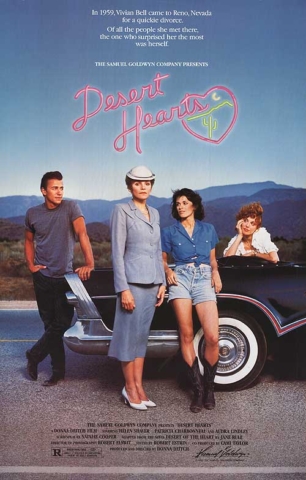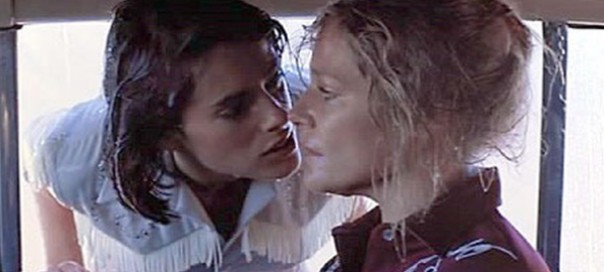That changed when out filmmaker Donna Deitch released “Desert Hearts,” the pivotal 1985 film starring Helen Shaver and Patricia Charbonneau as two women who engage in a heated romance in Reno, Nevada, 1959. Adapted from a Jane Rule novel (“Desert of the Heart”), the story of forbidden love was the first of its kind to give two women a happy ending, a much-needed piece of proof that real lesbian and bisexuals could cling to in a landscape devoid of representation.
“Desert Hearts” is often listed as a favorite lesbian film. It’s a classic, one that is being celebrated this week at the Museum of Modern Art on its 30th anniversary of release. Donna, Helen and Patricia will all be in attendance for a special event on Saturday night, followed by a party with the director and stars at Henrietta Hudson.
We spoke with Donna about “Desert Hearts,” the possibility of a sequel and her work on television over the last three decades.
GO: It’s been 30 years—does that feel long for you or like yesterday?
Donna Deitch: Well, you know what? It feels a little bit of both in the sense that I seem to have some sort of total recall on the process of making this movie and everything about it. My memory is not that great, typically. So in that way it seems very, very close to me and yet, much has transpired in the meantime. And in that way, it feels far away. But if I were to choose between the two, I’d say close.
GO: Is it a daily thing that people ask about this movie or bring it up to you? How much of your identity is tied to “Desert Hearts”?
DD: Well, it doesn’t come up for me every day, certainly. In many ways, often great vast periods of time goes by, and I forget about it. I, in fact, forgot about the 30th anniversary during the year of the 29th, which I wasn’t thinking was the 29th as well. And then I got this invitation from the British Film Institute for a 30th-anniversary screening, and that’s what reminded me that it was the 30th. But sometimes—it depends what’s going on, but I’ll run into people, or I’ll be somewhere, and it will sort of erupt back onto the surface. An amount of time goes by, and it’s not just not present.
GO: But now it’s probably very much on your mind with the anniversary. Do you ever watch it? How do you feel when you watch it now?
DD: It’s sort of like an old, old, old good friend that you haven’t seen for years or months, but when you see them, everything is just the same as it was the last time you saw them. Every connection is there, the shorthand and communication, closeness, everything is there again as though no time has elapsed. And that is my relationship with that film, and the actors and the DP and the crew and all of that when I run into them. I don’t watch it very often, but the really astounding experience that I had at the British Film Institute in the spring was that I saw a 35 millimeter print in all of its glory up on the screen at one of the best theaters in Europe. Normally when you make a film, and you shoot in 35, you see it a number of times when it opens in theaters all over the place as it makes it rounds on the festival circuit tour at its openings, but then you don’t see a 35-millimeter print projected again. And so you may not ever see it again, or you may see it if the occasion arrises, which is what happened at the British Film Institute and what will happen again at MOMA. Because now there are very few venues that screen 35 millimeters and have the capacity to do it. If you’re lucky enough to get an invitation to that, it’s truly—it’s breathtaking. And I became very, very emotional at the BFI screening because I hadn’t seen it in 29 years in all of its 35-millimeter glory, which is what I’m going to see on this run. In order to avoid overreaction, I gotta take a beta blocker.
GO: Whatever works! There’s been a rumor of a sequel for a while—is that a reality?
DD: That is a reality—I’m working on that now. I’m in the process of writing it. I’ve always wanted to do it; it’s just sort of been on the back burner of my life. After I made “Desert Hearts,” I was hired by Oprah Winfrey to direct “The Women of Brewster Place” on ABC, a mini-series. That was my first job as a director hired by somebody else. I kind of fell into television and I’ve been doing that for 25 years. So the “Desert Hearts” sequel, which was always my intention, kind of got pushed back. I’m really on it now because I’m in a period where I’m going back to being an independent filmmaker again, and I want to make the films that are important to me—and “Desert Hearts” is right up there. So I’m in the process of writing the screenplay and raising the financing to make the film.
GO: Is television getting better at providing opportunities for women?
DD: Well it was a very—and still is, it’s not as though that much has changed—but when I started doing it, there were very, very few. The landscape was just not populated by women directors. The percentages—I mean, they’re low now, they’re still horribly low, but they were even lower then. That is starting to change in part because, first of all, there’s a lot more content, which means a lot more people have to be hired to fill a lot more jobs. And secondly, when I first started, there were not any really female creators like Shonda Rhimes, Lena Dunham, Jill Soloway. There were not female-friendly producers with their own shows and now [there are] multiple shows. So that’s really, really encouraging because those are the people with the power to hire directors.
GO: When you’re on a set, is it still a mostly male crew? Does it feel like there’s any parity?
DD: Some parity has come. But again, typically, in the more female-friendly places. There are shows—and these numbers are available on the DGA website—the number of shows, named, that haven’t hired any female directors. So it has changed, and it has changed for the better, and it has a very long way to go. Not only are women not being hired as directors, but the same with their stories. They’re 53 percent of the population. Women’s stories should relate to that percentage and reflect it.
GO: There was a rumor that Ilene Chaiken had the cast of “The L Word” watch “Desert Hearts” to know what a good lesbian sex scene looked like. Is that true?
DD: I don’t know—that’s what I read.
GO: And you never worked on that show, right?
DD: No, I didn’t, no.
GO: It kind of surprises me they wouldn’t have you involved. Is there a reason for that?
DD: I don’t know what the reason is. No, I don’t know.
GO: Seems like a natural fit in that way!
DD: [laughs] I may have just been working elsewhere or unavailable. I don’t have any information on that.
GO: Is there a recent film or TV show that you feel does lesbian sex and sexuality really well?
DD: I think that “Transparent” is—it’s one of my favorite shows and I would just say that everything it deals with, including lesbian sexuality, is done brilliantly like no one has ever done it before. That’s how I feel. And I hugely admire that show and Jill Soloway. So that’s one I’d bring up. I can’t get it out of my mind—it’s truly powerful and original which is a combination that’s hard to achieve.
GO: You have some Q&As and events set up around the screenings—can you tell me a little bit about them?
DD: Tonight I’m doing a Q&A with Robin Morgan. Robin Morgan is an author and a poet, a writer, and she has 30 books out there. She is one of three co-founders, the other two being Gloria Steinem and Jane Fonda, of the Women’s Media Center. I was on the board of that for five years, and Robin is an old friend of mine. She is probably one of the most brilliant and lucid people I’ve ever met. She’s a feminist forever and if you really want to tune into a show that talks about women and want’s going on for women, go to Women’s Media Center Live with Robin Morgan on iTunes. Every week she is talking to women and dealing with subjects that I don’t think anybody else is. I wanted to find somebody a hell of a lot smarter than me—it’s not that hard to do but I came up with Robin. I thought ‘I want to have a really good conversation that contextualizes this movie,’ and so I started to think about who could do that best and I arrived at Robin. Robin is also very famous for the essays she wrote called “Goodbye to All That.” She wrote one in the ‘70s; she wrote another one in 2008 when Hillary was running the first time, and she just wrote another one that came out yesterday. In the face of this horrible election debacle, she wrote another one. It’s really worth taking a look at.
We are going to talk about everything about making this film and offer an opportunity to the audience to ask any question they ever had about “Desert Hearts.” So it should be a lot of fun. They are so thrilled—they both came into town for this. We all love each other and had the best time making this movie, and it’s still very much alive in our lives and our journey afterward. That’s going to be really fun. I’m going to encourage people to come back again. There’s a big party at Henrietta Hudson and Helen and Patricia and I will be there.
MoMA Presents: Donna Deitch’s “Desert Hearts” December 2 – December 8. Tickets and information on screenings and events are available at MOMA.org.



What Do You Think?